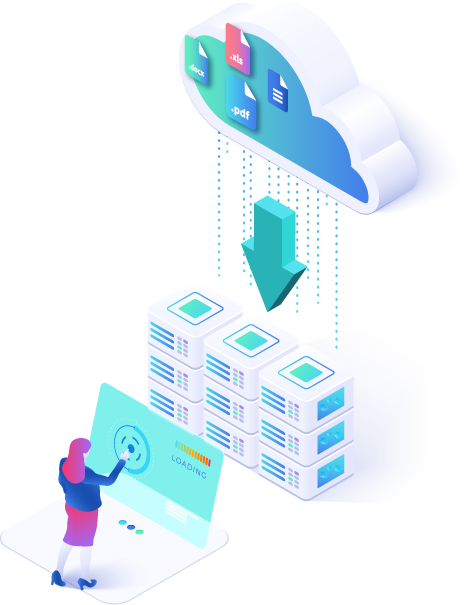Are you considering the transition of data from one cloud system to another? Many organizations are taking this crucial step to improve efficiency, reduce costs, or enhance functionality. Some are led by practical reasons, such as the merger of two companies using different cloud technologies, and all are facing the need to explore cloud migration strategies.
Such a pivotal move demands foresight and strategic planning.
The cloud to cloud migration step provides your organization the opportunity to choose a cloud service that more closely aligns with your specific needs and budget constraints. This is relevant given that various cloud providers present different pricing models, storage options, and specialized services.
As a cloud migration tool, we possess extensive insight into various migration strategies and best practices. This guide is crafted from our broad experience to assist you in meticulously planning your migration process for optimal results.

Clever Planning, Smooth Migration
Cloud to cloud transfer is similar to planning a major relocation. If you pack everything haphazardly, you’ll likely face challenges locating items later, and there’s a higher risk of damage. The initial step in data migration requires a thorough assessment of the data you intend to move, focusing on its distribution and volume. This involves understanding not just the quantity of data but also its type, permissions, security settings, and shared data are maintained. Following this, you need to meticulously plan the new environment you’re migrating to. This means ensuring that the new cloud system is ready to handle the volume and type of data you’re moving, has the necessary security definitions, and is structured to optimize accessibility and efficiency. Such detailed planning is essential to ensure a seamless transition, minimize downtime, and safeguard the integrity of your data throughout the migration process.
Automation: A Key to Successful Cloud Migration
In this crucial organization step it’s important to recognize the risks linked to manually transferring data, especially the likelihood of data loss. These risks become more pronounced in situations where large amounts of data are involved or the migration paths are complex.
The role of automation in cloud migration is immensely beneficial, as it simplifies the process and diminishes the risks inherent in manual data transfers. Automation is particularly indispensable in scenarios that demand the most precision and efficiency in transferring data.
Delta Migration: Streamlining Data Updates in Cloud Migration
In today’s fast-paced business environment, data is not static; it constantly evolves and gets updated. Traditional migration methods, which involve transferring a static snapshot of data, often fall short of keeping up with these ongoing changes. This is where delta migration comes into play, offering a dynamic solution.
Delta migration specifically addresses the need to manage and synchronize data changes during the migration process. Instead of migrating the entire data set repeatedly, delta migration focuses on transferring only the data that has changed or been newly added since the last migration. This approach is not only efficient but also ensures that the migrated data is a current and accurate reflection of the source data.
For organizations, this translates into improved control over your data. As you transition to the cloud, you can maintain your operations seamlessly, avoiding concerns about inconsistencies between your legacy and new systems. This ongoing synchronization is vital for businesses that depend on the accuracy of real-time data.
Security Migration: Preserving Permissions in The New Cloud System
Maintaining consistent permissions and sharing settings during cloud migration is a substantial challenge faced by many organizations. As data moves from one cloud system to another, there’s a critical need to ensure that access controls, security protocols, and collaborative settings are not just preserved but also accurately replicated in the new environment.
During the migration, it’s important to ensure that external collaborators maintain their access without disruption. This requires a migration process that can recognize and replicate external sharing settings in the new system.
A successful security migration strategy not only preserves the integrity and accessibility of data but also ensures that all security and collaboration settings are seamlessly transitioned to the new cloud environment, maintaining operational continuity and data security.
Ensuring Security by End-to-End Encryption
Securing data during the migration process is a concern for many organizations, particularly in an era where data breaches and cybersecurity threats are increasingly common. The importance of this issue cannot be overstated, as data in transit is often more vulnerable to unauthorized access and corruption. The complexity arises from the need to protect the data while it moves across different networks and platforms.
Therefore, we recommend using an end-to-end encrypted migration tool. End-to-end encryption is more than just a security measure; it is a fundamental component of a successful and secure cloud migration strategy.
End-to-end encryption provides a robust shield, safeguarding data against unauthorized access and potential corruption. The essence of end-to-end encryption lies in its ability to encrypt data at the source and keep it encrypted throughout its journey until it reaches its destination. This means that the data, while in transit, is rendered unreadable to anyone other than the intended recipient. Even if the data were to be intercepted during the migration, the encryption renders it indecipherable and useless to unauthorized entities.
Implementing end-to-end encryption also plays a pivotal role in maintaining compliance with stringent data protection laws and regulations. By encrypting data throughout the migration process, organizations can ensure adherence to standards like GDPR, HIPAA, and others that mandate high levels of data security. This not only protects the data but also shields the organization from potential legal and reputational repercussions associated with data breaches.
Moreover, end-to-end encryption aids in preserving the integrity of the data. Ensuring that data is not altered or tampered with during migration is essential for the accuracy and reliability of the information once it reaches its new cloud environment. This is particularly significant for organizations that rely heavily on data accuracy for their operations.
Summing Up
The range of cloud migration strategies discussed here is crucial in ensuring a smooth and effective data migration process. Every strategy serves a key function in meeting the unique requirements and obstacles involved in transferring data to the cloud.
By thoughtfully choosing a migration tool that encompasses all these strategies, from aiding in migration planning and preserving permissions and access controls to optimizing delta migrations for efficiency and securing data with end-to-end encryption, you can effectively streamline the migration process




